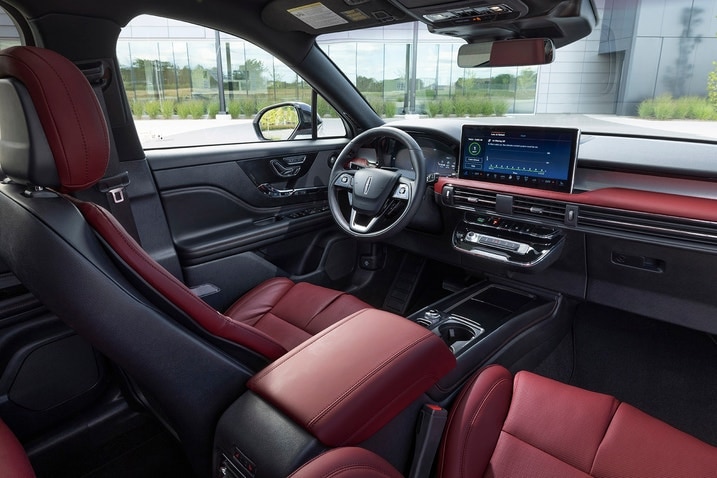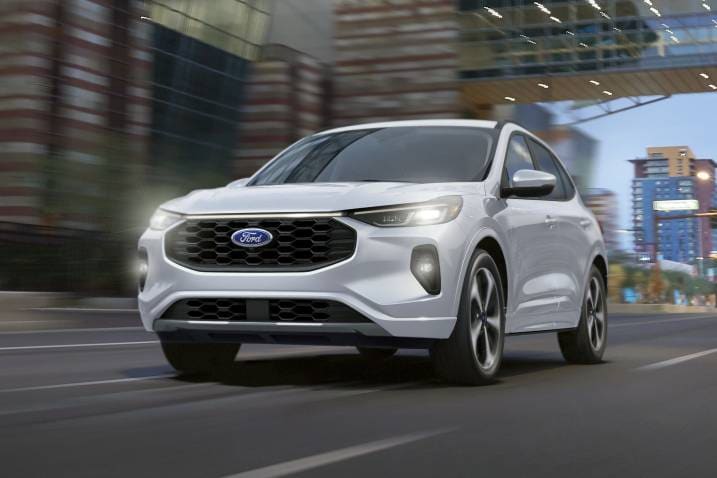- Ford's Escape is a decent family runabout offering gas and plug-in-hybrid powertrains.
- The Lincoln Corsair adds style and finery to the mix but has a more cramped interior.
- Which of these compact American crossovers is right for you?
2025 Ford Escape vs. Lincoln Corsair: Is the Luxury Pick Worth It?
The Escape and its cousin the Corsair offer two of the same powertrains but differ in feature content and trimmings
The Ford Escape and Lincoln Corsair compact crossovers are some of their respective brands' top-selling models. The two are built on the same platform — in the same plant, in fact. And they'll soon be put out to pasture as the Kentucky factory where they're assembled retools for an upcoming midsize Ford electric pickup truck.
But these two are not gone yet. The automaker promises supplies of both the Corsair and Escape will continue "well into 2026." Before they exit, we're comparing them to show you what you get by upgrading to the fancier Lincoln model versus sticking with the more mainstream Ford.
For this comparison, we're ignoring versions of the Escape powered by the 1.5-liter EcoBoost three-cylinder and standard hybrid system. The Corsair's two available powertrains — a 2.0-liter four-cylinder and a plug-in hybrid — overlap with similar versions of the Ford, so that's what we'll focus on here.
Ford Escape vs Lincoln Corsair: Powertrains compared
Ford Escape 2.0-liter | Ford Escape Plug-in Hybrid | Lincoln Corsair 2.0-liter | Lincoln Corsair Plug-in Hybrid | |
|---|---|---|---|---|
| Engine | turbocharged 2.0-liter inline four-cylinder | 2.5-liter inline four-cylinder, two electric motors | turbocharged 2.0-liter inline four-cylinder | 2.5-liter inline four-cylinder, two electric motors |
| Horsepower | 250 hp | 210 hp | 250 hp | 266 hp |
| Torque | 280 lb-ft | 155 lb-ft | 275 lb-ft | N/A |
| Transmission | eight-speed automatic | continuously variable automatic | eight-speed automatic | continuously variable automatic |
| Drive type | all-wheel drive | front-wheel drive | front-wheel drive/all-wheel drive | all-wheel drive |
| Fuel economy | 26 combined mpg (23 city/31 highway) | 40 combined mpg, 37 miles of electric range | 24-25 combined mpg (21-22 city/28-30 highway) | 33 combined mpg, 27 miles of electric range |
Engines and fuel economy
Starting with the versions equipped with turbocharged 2.0-liter engines, it's a pretty fair fight, with both the Ford and the Lincoln putting out 250 horsepower. Curiously, the Escape tips the Corsair with 5 additional lb-ft of torque, though both are pretty punchy for compact crossovers. The main difference here is that Ford only sells the 2.0-liter with all-wheel drive, whereas Lincoln offers it with both front- and all-wheel drive. Fuel economy numbers are pretty close, too, and you can see the full specs in the chart above.
Things get a little more interesting when you look at the plug-in hybrids' specs. While the most efficient Escape has a modest 210 horsepower, the plug-in Corsair uses the same 2.5-liter engine paired with more powerful electric motors to generate 266 horsepower. Here again, there's a driveline mismatch, with Ford's version offered only with front-wheel drive and Lincoln's limited to all-wheel drive.
With less power and fewer driven wheels, the Ford tops the Lincoln's EPA fuel economy ratings. Both use a 14.4-kWh battery pack that can be charged at home or on the go, but the plug-in Escape's efficiency advantage translates to more electric-only range — 37 miles versus the Corsair's 27 miles.
Interior
Our two contestants share a 106.7-inch wheelbase, but the bodies that sit atop differ in proportions. The Escape's more upright shape and squared-off rear end best the swoopier Lincoln in terms of space for both people and their gear. As the measuring tape shows, headroom is more generous in the Escape, and it also offers a couple more inches of rear legroom than its luxe counterpart. The difference is most stark when you look at cargo volume behind the rear seats, where the Ford has as much as a 10-cubic-foot advantage.
One other thing to note is that the plug-in versions of both have less rear legroom and aren't as capacious as their gas-only siblings. This is because the battery pack and other hybrid electronics steal some space from the passenger and cargo areas. Buyers looking to haul the most gear should keep this in mind.
The Escape is available with either a combo of cloth and vinyl or full vinyl seating surfaces. At Lincoln, all Corsairs feature premium leather upholstery. Plus, the Lincoln's interior is quieter than the Ford's since the Corsair comes with active noise cancellation and luxury brands tend to spend more on sound deadening materials.
Interior dimensions compared
Ford Escape 2.0-liter | Ford Escape Plug-in Hybrid | Lincoln Corsair 2.0-liter | Lincoln Corsair Plug-in Hybrid | |
|---|---|---|---|---|
| Headroom (front/2nd row) | 40.0 in / 39.3 in | 40.0 in / 39.3 in | 39.5 in / 38.7 in | 38.4 / 38.4 in |
| Legroom (front/2nd row) | 42.4 in / 40.7 in | 42.4 in / 38.9 in | 43.2 in / 38.6 in | 43.2 / 36.7 in |
| Number of seats | 5 | 5 | 5 | 5 |
| Cargo volume (2nd row up) | 37.5 cu ft | 34.4 cu ft | 27.6 cu ft | 26.9 cu ft |
| Cargo volume (2nd row folded) | 65.4 cu ft | 60.8 cu ft | 57.6 cu ft | 56.2 cu ft |
Technology and safety equipment
An 8-inch center touchscreen running Ford's Sync4 infotainment software comes standard on lower-trim Escapes. That can be upgraded to a 13.2-inch display, and the larger screen comes standard on more expensive models. If you go for the Lincoln, you'll get a 13.2-inch touchscreen no matter which trim you select. It's a similar story in terms of digital gauges; a 12.3-inch display is available on the Escape and standard on all Corsairs. No matter the infotainment system fitted, all versions of the Ford and Lincoln include wireless Apple CarPlay and Android Auto.
A basic version of Ford's Co-Pilot360 safety suite is standard on all Escapes and includes automatic headlights and high-beams, blind-spot monitoring with rear cross-traffic braking, lane keeping alert and assistance, automatic emergency braking with pedestrian detection, and road departure warning. An Assist+ upgrade adds adaptive cruise control, lane centering assist, evasive steering assist, intersection assist, and rear parking sensors, while the Assist 2.0 package has all of that plus reverse brake assist. A 360-degree camera system is also available.
The Corsair comes with Lincoln Co-Pilot360 2.0; it includes everything in Ford's Co-Pilot360 Assist+ group. Adding the Vision package brings a 360-degree camera system, parking sensors all around, and reverse brake assist. There's also a Drive package that includes the BlueCruise hands-free driving system, active park assist, an advanced version of intersection assist, and a driver-monitoring camera.
Trims and pricing
If you're after the least expensive Escape, you're looking at a front-wheel-drive Active model powered by the 1.5-liter three-cylinder with a starting price of $31,010, which includes a $1,495 destination charge. But in terms of Escapes that are comparable to a Corsair, pricing starts at $34,690 for an all-wheel-drive ST-Line Select, which comes standard with the 2.0-liter.
The least expensive 2.0-liter Corsair, meanwhile, is the Premiere, which will set you back $42,055 for a front-wheel-drive version (again, including a $1,495 destination charge), or $44,355 for one with all-wheel drive like the Ford has. Stepping up to the plug-in hybrids, Ford asks $39,895 for the Escape PHEV, while Lincoln charges $55,860 for a Corsair Grand Touring, the sole Corsair that has the plug-in powertrain.
Ford's warranty has three years/36,000 miles basic coverage and five years/60,000 miles for powertrain (or eight years/100,000 miles for the hybrids). Lincoln ups that to four years/50,000 miles basic and six years/70,000 miles for the powertrain (or the same eight years/100,000 miles for hybrid versions). Ford gives you roadside assistance for five years/60,000 miles, whereas Lincoln includes it for life.
The Lincoln's nearly $9,000 price premium gets you a cushier ride, a little more standard safety tech, a larger center touchscreen, nicer interior materials, and longer warranty coverage. It also opens up availability of the BlueCruise system, something the Ford doesn't offer. But the Corsair isn't quite as roomy and can't match the Escape's cargo-hauling capabilities.
The Ford is the clear value winner here, but it's not hard to make a case for the more polished Lincoln. If you have a little extra cash to spend and want something softer and more refined, the Lincoln will be worth the extra coin.






 by
by  edited by
edited by